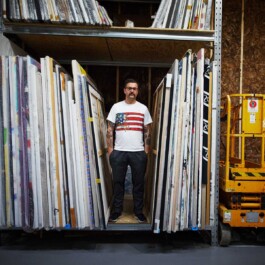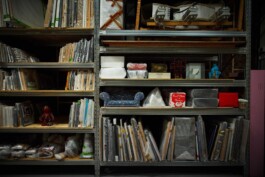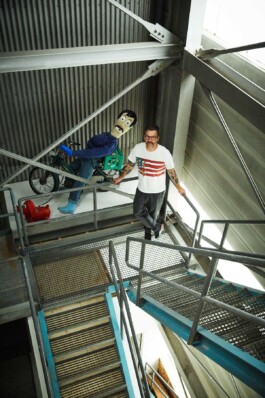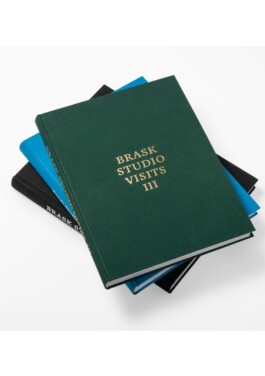CLICK ME
Menu

Jens-Peter Brask is a courageous man. After running a small restaurant imperium for almost 20 years he decided to jump ship and instead pursue a career in art. That was only three years ago. Since then Brask has already made a name for himself, curating art for museums, public projects, his own book series and a growing range of private collectors who needs his insights to build a collection. We sat down with Brask in his office filled to the brim with artworks to discuss curation, networking, and the next big thing.
Jens-Peter Brask, thanks for inviting us in. We are surrounded by art. If these walls could talk…
There’s quite a bit, right. I have been collecting art as a hobby for 25 years, and only worked with it professionally during the last three years.
Tell me about the old days. How did you get into art to begin with?
My background is in graffiti. I painted graffiti from 1986 when the wave from America hit Denmark. I watched Style Wars, bought Subway Art and everything else I could get my hands on. I was active as a graffiti artist from 1986 to 1994, and then my graffiti career evolved naturally into a general interest in contemporary art. I began collecting, and that’s 25 years this year.
But only as a hobby to begin with?
Correct. I was in the restaurant business for more than 20 years. I kept myself busy with a handful of places here in Copenhagen and had a nice business going.
.. but you wanted something else?
Yes. Eventually, I decided that it was time for a new venture. And three years ago I sold off everything.
That’s quite courageous. And quite a change.
The first year I couldn’t come to peace with the fact that my phone never rang anymore. I had a hard time finding myself because nothing really happened and I was used to constantly being surrounded by questions, decisions and people. My phone went almost completely silent, and that’s a bit weird after so many busy years. But after a while, I came to terms with it and found my new way in life.
And that was art?
It was art. As I said I had been collecting for 25 years, but not only that, I had also found an interest in curating. I just didn’t know it back then. I realized that basically, my entire life was curating. Curating art, curating projects, bringing people together and letting ideas prosper. I curate books, I curate murals, I curate exhibitions of my own collection at some of the most interesting art institutions in Denmark: Arken, J.F. Willumsens Museum, Kunsten and Heerup Museum. I curate collaborations with Normann Copenhagen. I curate art for private people whom I help build and maintain private collections.

We meet Jens-Peter Brask in his office in the outskirts of Copenhagen.
The artworks are lined up on a massive shelving system that covers all walls. It’s like a record collection, just on a much bigger scale. The industrial space has a ceiling height of 8-10 meters, and there’s access to a room above it that is currently being used as Jens Peter’s own exhibition space.
Everywhere you look there’s art. Art coming in, recently bought from galleries or directly from artists, or art going out to exhibitions and museums. Art ready to be stocked, art ready to be admired. Near the end of our visit, Jens-Peter starts loading his black Volvo with editions of his Brask Studio Visits for the temporary store at an exhibition about graffiti. An exhibition in which he has played a significant role. Bridging the gap and bringing art from the streets to the galleries and museums, you’ll have a hard time finding a better representative than Jens-Peter.


“Consider art as something you buy and appreciate. If it increases in value, it’s just a plus."
– Jens-Peter Brask

I think it’s really impressive what you’ve achieved during the relatively short timespan from when you left the restaurant business to where you are today. It sounds pretty easy, but I guess you got your hands dirty in the process.
Indeed. During the transition phase from my restaurants to my art business I worked intensely on shaping my craft and building the storytelling around me being a curator. It takes a huge amount of courage to change career tracks at 44. I went from regular, monthly earnings from healthy companies to an insecure business model and an insecure future. But it was my very own decision, and I was only responsible for it myself. I simply needed to erase everything on my eternal hard drive and do something else, including a complete rebrand of myself. That meant networking, and interviews.
Just being out there. I guess a huge part of your job is to be present and know people.
Network is a huge part of my job. I’m well connected in Europe and in the States. And it’s actually quite simple: Say, I know an artist in New York. He introduces me to his assistant, and because I have a natural interest in emerging talents I show interest in his work as well. And next time I’m in the city, his assistant might work for a different artist, so I go and visit them and become introduced to their friends. And then it keeps going. Once the network thing gets rolling, it’s kind of like a snowball effect.
Let’s play with the idea that I want to start building a collection. What is it that I get from working with you?
I have collected art for 25 years. I know the galleries, I know what’s good and what’s not, and how you approach the art of buying art. I’m good at understanding aspiring collectors and what they look for in art. And because I know so much art and so many people, I’m able to filter out 80% of the noise you might have to go through yourself. My first assignment is to remove that so we can focus on what matters.
Is it going to be expensive for me to start an art collection?
It’s not about how much money you wish to spend. The important part is that we have to find good art for your walls. When we initiate a collaboration the collector pay a fee upfront to confirm that their interest is real. I don’t charge anything on top of the price of the artwork. Instead, it’s the gallerists that pay me a cut for connecting a collector with one of his artists.
Is art a safe place to put your money?
I will never be able to promise collectors that their purchased artworks are going to increase in value. Nobody knows. But I have an idea about if a certain artwork is going to age well or not.
I guess it’s an investment like everything else?
No, I don’t see collecting as an investment and I never advise collectors to do it for the money. Consider art as something you buy and appreciate. If it increases in value, it’s just a plus.
You become a trusted advisor for many. How do you discover all this art?
My radar is constantly on. And Instagram! The artists are extremely good at sharing and connection on social media. An example is the artist Farshad Farzankia, a Danish-Iranian painter who always liked and commented on my posts. One day I checked out his profile and found not only a rapidly growing following, but also an incredibly talented painter and an eagerness to create. I visited him in his studio shortly thereafter and met a humble guy that I became acquainted with and has followed since. I included him in edition three of my Studio Visits books.
Is there a wrong way of approaching the concept of buying art?
During the latest Art Basel I saw Rihanna buying art. It’s amazing when a person with her impact has an interest in art. She has the financial freedom to build a collection in bascially an hour. Just pick this Jeff Koons, that Richard Prince, this Willem de Kooning, that Asger Jorn. She would be a collector and a force to be reckoned with, but in my opinion she wouldn’t be a collector from the heart.
How so?
I think it’s much more fun to discover artists at a very early stage and support them by buying their works and promoting them by connecting them. To collect not because of your love for money but for art.


Jens-Peter Brask is renowned for his sequential book series Brask Studio Visits in which he visits emerging and established artists in their studios. He photographs, interviews and produces everything himself.
To learn more about his publishing venture, check out Brask Publications.
Brask Publications
Blegdamsvej 6, 1st floor
Copenhagen, Denmark
Telephone +45 3232 3232
journal@weareheadlight.com
© 2020 Headlight Journal. All rights reserved.
Blegdamsvej 6, 1st floor
Copenhagen, Denmark
Telephone +45 3232 3232
journal@weareheadlight.com
© 2020 Headlight Journal. All rights reserved.